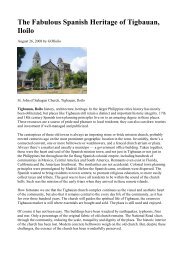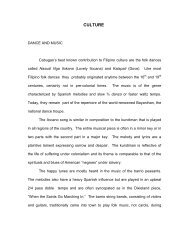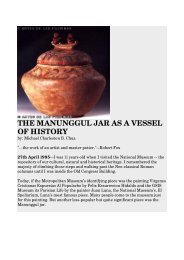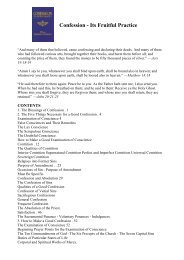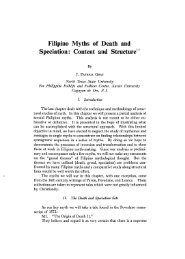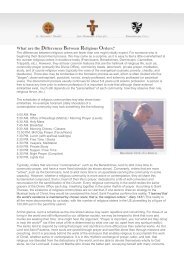Culture Beliefs and Practices in Malingin - Philippine Culture
Culture Beliefs and Practices in Malingin - Philippine Culture
Culture Beliefs and Practices in Malingin - Philippine Culture
Create successful ePaper yourself
Turn your PDF publications into a flip-book with our unique Google optimized e-Paper software.
<strong>Culture</strong> <strong>Beliefs</strong> <strong>and</strong> <strong>Practices</strong> <strong>in</strong> Mal<strong>in</strong>g<strong>in</strong>Accord<strong>in</strong>g to Philipp<strong>in</strong>e history books, the aborig<strong>in</strong>e of the Filip<strong>in</strong>os is the Negritos who werefive feet tall; hav<strong>in</strong>g dark k<strong>in</strong>ky hair, flat nose <strong>and</strong> black sk<strong>in</strong>. They were believed to beuncivilized <strong>and</strong> were nomads.Thous<strong>and</strong>s of years past, the Malays (people from Malaysia <strong>and</strong> Indonesia) came to the countryvia sea aboard <strong>in</strong> a boat called “Balangay”. The term was later on used to refer to a small unit ofgovernment of the early Filip<strong>in</strong>os, the Barangay.There are also evidences found <strong>in</strong> caves of Palawan about the early <strong>in</strong>habitants of the countrythat were believed to reach the country through the l<strong>and</strong> bridges.In the later years, Ch<strong>in</strong>ese were able to arrive <strong>in</strong> the Philipp<strong>in</strong>es to trade.In 1521, Spaniards headed by Ferd<strong>in</strong><strong>and</strong> Magellan came to the Philipp<strong>in</strong>es <strong>and</strong> l<strong>and</strong>ed <strong>in</strong> theisl<strong>and</strong> <strong>in</strong> Cebu. Thereafter they converted the native of Cebu from Paganism to Christianity <strong>in</strong>accordance with their purpose of voyage, the three G’s: gold, glory <strong>and</strong> government. ThePhilipp<strong>in</strong>es became the colony of Spa<strong>in</strong> for more than 300 years spread<strong>in</strong>g Roman Catholicism.That is why at the present Philipp<strong>in</strong>es is known as the only Christian Nation <strong>in</strong> the Far East.Spanish rule ended <strong>in</strong> the year 1898, leav<strong>in</strong>g the country <strong>in</strong> the h<strong>and</strong>s of Americans by the virtueof the “Treaty of Paris” on December 10, 1898.Filip<strong>in</strong>os were greatly <strong>in</strong>fluenced by the American customs <strong>and</strong> traditions <strong>in</strong>clud<strong>in</strong>g the systemof government dur<strong>in</strong>g the time of Americans.In 1941, the Second World War broke out. The jo<strong>in</strong>t forces of the Allied Powers <strong>and</strong> the Filip<strong>in</strong>osoldiers fought aga<strong>in</strong>st the Japanese that brought an end to the Japanese occupation <strong>in</strong> thePhilipp<strong>in</strong>es <strong>in</strong> 1945. Americans recognized the country’s <strong>in</strong>dependence on July 4, 1946 butFilip<strong>in</strong>os first declared it on June 12, 1946 under General Emilio Agu<strong>in</strong>aldo mak<strong>in</strong>g Philipp<strong>in</strong>esa free <strong>and</strong> democratic country up to date.In general, the Negritos, Malays, Ch<strong>in</strong>ese, Spaniards, Japanese, Americans greatly contributed tothe present way of life of the Filip<strong>in</strong>os. This made Filip<strong>in</strong>o race a complex race hav<strong>in</strong>g variouscustoms, traditions, beliefs, <strong>and</strong> even philosophy.In general Filip<strong>in</strong>os are known to be hospitable, family-oriented, hardwork<strong>in</strong>g, religious, joyful<strong>and</strong> humorous, fatalistic, passive.Traditions:Accord<strong>in</strong>g to the def<strong>in</strong>ition, traditions are customs, beliefs, practices that are passed on fromgeneration to generation. Here are some of Filip<strong>in</strong>o traditions that are common to the people ofMal<strong>in</strong>g<strong>in</strong>.From Nihal – Feb 15, 2008 1/4
Customs:Christmas Day <strong>and</strong> New Year’s Eve-dur<strong>in</strong>g these celebrations, you will notice that people prepares food <strong>and</strong> shares it with theother members of the community. Most of the time, people prioritize the New Year’s Eve thanthe Christmas Eve. For the “noche buena” (dur<strong>in</strong>g Christmas eve) they usually prepares a loaf ofbread with a spread <strong>and</strong> a softdr<strong>in</strong>k, unlike <strong>in</strong> “media noche” (dur<strong>in</strong>g New Year’s eve) where <strong>in</strong>families cooks food like spaghetti, salad, valenciana, <strong>and</strong> other foods for special occasions. As an<strong>in</strong>fluence from the Ch<strong>in</strong>ese, everyone makes sure that they have firecrackers to light for the NewYear’s Eve. The firecrackers is said to throw away bad luck from the house <strong>and</strong> family, <strong>and</strong> towelcome good luck for the com<strong>in</strong>g year. There are also various th<strong>in</strong>gs that people <strong>in</strong> thecommunity do before <strong>and</strong> dur<strong>in</strong>g the New Year. Each house sees to it that the house is clean <strong>and</strong>th<strong>in</strong>gs like curta<strong>in</strong>s, pillowcases, blankets are newly washed. As a family-oriented people,parents make it sure that all their children are together <strong>in</strong> the house dur<strong>in</strong>g the New Year’s Eve.As much as possible the family refra<strong>in</strong>s from buy<strong>in</strong>g <strong>and</strong> go<strong>in</strong>g out of the house dur<strong>in</strong>g the firstday of the year because if that happen, all year round, you will be buy<strong>in</strong>g <strong>and</strong> you won’t stay <strong>in</strong>your house. That is why whatever bad or unreasonable practices are avoided dur<strong>in</strong>g the first dayof the year.Fiesta celebration (a celebration for the patron sa<strong>in</strong>t of a particular place)-this event is often started with a mass <strong>in</strong> the morn<strong>in</strong>g honor<strong>in</strong>g the patron sa<strong>in</strong>t of the place.Then this will be followed of either parade of the place’s officials <strong>and</strong> members, as well as themuses; a short program; parlor games (often times there is a “palo sebo”-a game where<strong>in</strong> thefacilitators will place a very tall bamboo pole at the center of the venue/plaza, full of grease tomake it slippery with a prize at the to end of the pole. Participants should get the prize byclimb<strong>in</strong>g the pole to its top end. Participants cooperates with each other to get the price <strong>and</strong> thenlater divide it by themselves.); sports activities (basketball league, volleyball); playgrounddemonstration; cockfight<strong>in</strong>g/derby; drag rac<strong>in</strong>g; fluvial parade (places near the sea/river); bullfight<strong>in</strong>g; <strong>and</strong> many more. The celebration is highlighted by the crown<strong>in</strong>g of the fiesta queenfollowed by a benefit dance.*Al C<strong>in</strong>co de Noviembre-This commemorates the <strong>in</strong>genuity of Bagonhons. This is exemplified by the action ofGeneral Juan Araneta when he bluff the Spaniards by us<strong>in</strong>g fake cannons <strong>and</strong> arms <strong>and</strong> wonfreedom for the Negrenses In commemoration of that creative endeavor we today cont<strong>in</strong>uouslyprove that we can be creative <strong>and</strong> orig<strong>in</strong>al <strong>in</strong> our approaches to life. The Bago City Governmentcelebrates that event with gleeful rem<strong>in</strong>iscence <strong>and</strong> pride for a great General <strong>and</strong> his gallant menfrom this City who armed with courage <strong>and</strong> <strong>in</strong>genuity played a great role <strong>in</strong> the history ofNegros. Spanish authorities <strong>in</strong> Bacolod capitulated after see<strong>in</strong>g advanc<strong>in</strong>g troops armed withrifles <strong>and</strong> cannons which were actually nipa stalks <strong>and</strong> rolled sawali mats pa<strong>in</strong>ted black. AlFrom Nihal – Feb 15, 2008 2/4
C<strong>in</strong>co de Noviembre showcases not only the courage <strong>and</strong> gallantry but also the creativity <strong>and</strong><strong>in</strong>genuity of the Bagonhons. November 5 has been declared a holiday <strong>in</strong> Negros Occidental.*Babaylan FestivalThe babaylan Festival was conceived to highlight a unique br<strong>and</strong> of Filip<strong>in</strong>o heritage, onethat dates back to the pre-Spanish period. This festival aims to rediscover the region’s <strong>in</strong>digenousmusic, literature, dances, rituals <strong>and</strong> other artistic endeavors. A Babaylan is a doctor, herbalist,artist, medium, adviser, agriculturist <strong>and</strong> more, all rolled <strong>in</strong> one very <strong>in</strong>terest<strong>in</strong>g character. He isthe keeper of rituals <strong>and</strong> spirit agents <strong>in</strong> normal world. He <strong>in</strong>spires awe <strong>and</strong> fear. For this event,every barangay prepares for a street danc<strong>in</strong>g <strong>and</strong> a dance presentation depict<strong>in</strong>g the barangay’shistory to be performed after the street danc<strong>in</strong>g. Lately, due to the shortage of funds for thisfestival, a barangay merges with the other for them to be able to come up with a presentationwithout us<strong>in</strong>g much funds for the preparation. This is held dur<strong>in</strong>g the charter anniversarycelebration of the city of Bago.Pamamanhikan/Pakagon (Engagement)-this is the when lovers decides to settle <strong>and</strong> get married. The guy, together with his parents,some family members <strong>and</strong> relatives go to the house of his girlfriend. Both parties will talk aboutmatters regard<strong>in</strong>g their children’s decision to marry, whether they agree or disagree with thewedd<strong>in</strong>g proposal. if both parties agreed <strong>and</strong> approved the proposal, that’s the time to set a dateof the wedd<strong>in</strong>g, <strong>in</strong>clud<strong>in</strong>g the venue of the wedd<strong>in</strong>g <strong>and</strong> reception, the motif , the primary <strong>and</strong>secondary sponsors, best man, maid of honor, <strong>and</strong> other matters regard<strong>in</strong>g the wedd<strong>in</strong>g.Tigkalalag-this celebration is done for the honor/commencement of our loved ones who already passedaway. Celebrated <strong>in</strong> the 1 st (All Sa<strong>in</strong>t’s day) <strong>and</strong> 2 nd day of November. Several days before thesedates, family <strong>and</strong> relatives starts to clean <strong>and</strong> repa<strong>in</strong>t the tombs of their loved ones. Cemeteriesare overcrowded dur<strong>in</strong>g these days especially <strong>in</strong> November 1. Actually, this celebration shouldbe on the 2 nd day of November, but due to the old practice of the people November 1 has beenthe day where <strong>in</strong> they rush to the cemetery <strong>and</strong> visit. Most families br<strong>in</strong>g native foods like suman(made of “malagkit”-a sticky k<strong>in</strong>d of rice, with sugar <strong>and</strong> coconut extract), valenciana (made alsoof malagkit with yellow g<strong>in</strong>ger, chicken/pork meat, peas-specifically the green pea, rais<strong>in</strong>s, <strong>and</strong>season<strong>in</strong>g), <strong>and</strong> other delicacies mostly made from malagkit to be shared by the whole family.Because of the fact that everyone visits their passed-away loved-ones, this day also serves as areunion for the family. Some even stay at the cemetery until night. Because of this othercemeteries held a benefit dance at the premises of the cemetery.<strong>Beliefs</strong>:It is believed that buy<strong>in</strong>g needle <strong>and</strong> salt dur<strong>in</strong>g even<strong>in</strong>g may cause damage to the rema<strong>in</strong><strong>in</strong>gstocks of the said product.From Nihal – Feb 15, 2008 3/4
Dur<strong>in</strong>g a meal, if someone drops a spoon, a lady visitor is believed to be com<strong>in</strong>g. If it is afork a man is expected to arrive.Women hav<strong>in</strong>g their menstrual period are not supposed to plant especially flowers becausethe plant will die. They are also prohibited from go<strong>in</strong>g to the garden because the plants that theymight be stepped-over will die.People believe that if a hen is lay<strong>in</strong>g its egg <strong>and</strong> an earthquake strikes, the egg will not hatch.A member (Salustiana) has proved this belief.The first twelve days of the year is believed to represent the twelve months of the year. Jan.1-January, Jan. 2- February, Jan. 3-March, so on. This is often used by the elders to predict theweather. If it ra<strong>in</strong>s <strong>in</strong> Jan. 1, then the month of January is said to be a ra<strong>in</strong>y month, if it sh<strong>in</strong>es<strong>and</strong> it did not ra<strong>in</strong> <strong>in</strong> the 4 th of January, then the month of April will be a sunny <strong>and</strong> hot monthwith least expectation of ra<strong>in</strong>, <strong>and</strong> so on.<strong>Practices</strong>:Most of the beliefs mentioned above are still practiced by the people of the congregation butthere are still some that were already rejected due to the modernization <strong>and</strong> advancement oftechnology.At night everyone avoids sweep<strong>in</strong>g the floor because the luck <strong>and</strong> bless<strong>in</strong>gs are believed tobe swept out of the house too. If ever you really wanted to sweep the floor, you should not throwwhat you have gathered out of the house.Accord<strong>in</strong>g to folk beliefs, a pregnant woman should not go out of the house dur<strong>in</strong>g an eclipsebecause it is said that eclipse may cause abnormality to the baby after birth.Another practice is the shar<strong>in</strong>g of foods with neighbors especially the vi<strong>and</strong>. Every time afamily cooks someth<strong>in</strong>g special, they always share a bit of it to their neighbors. It is a mutualpractice of the resident. Maybe because the families are related to each other or Filip<strong>in</strong>os have ak<strong>in</strong>d heart towards others. Even other communities practice this k<strong>in</strong>d of shar<strong>in</strong>g.Cock fight<strong>in</strong>g enthusiasts dur<strong>in</strong>g mourn<strong>in</strong>g are not allowed to engage <strong>in</strong> any cockfightbecause the only possibility is to lose the game. Just the same if a member of the family is hav<strong>in</strong>gher menses.NOTE: For more details about the customs, beliefs, practices, history <strong>and</strong> events, naturalresources, <strong>and</strong> important <strong>in</strong>formation about the Philipp<strong>in</strong>es <strong>and</strong> its people, k<strong>in</strong>dly visit thebookstore <strong>in</strong> the locality <strong>and</strong> look for the book of David K<strong>in</strong>g’s, “Philipp<strong>in</strong>es - Know <strong>and</strong>Appreciate Our Homel<strong>and</strong>”From Nihal – Feb 15, 2008 4/4






